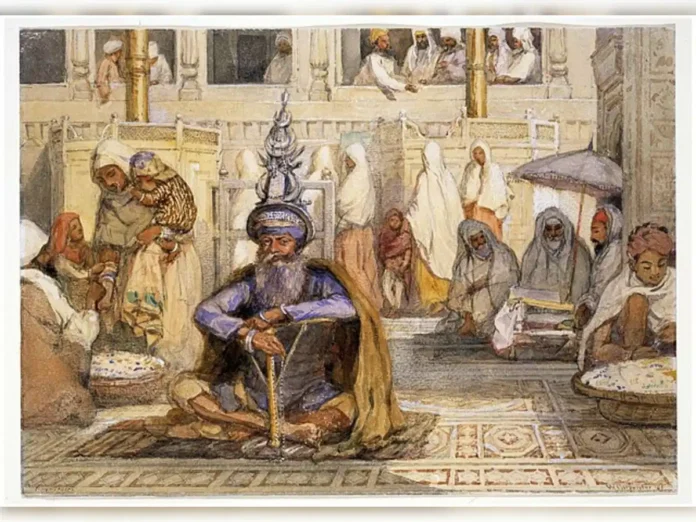- In November 1858, Nihang Sikhs, under the leadership of Baba, barged into Babri Masjid, performed hawan and wrote ‘Ram Ram’ everywhere on the walls of the Mosque and hoisted saffron flag
- Furthermore, they even constructed a makeshift platform inside the mosque and placed an idol of Lord Ram on it
- A case was registered against the Nihangs at the Awadh police station on November 30 and Thanedar Sheetal Dubey went to summon Baba who was living within the premises of the mosque
Sikhs have a special Relation with Ayodhya and Shri Ram, Something no Modern Day politicians likes to talks about. On 28th November, 1858, Nihang Sikhs from Punjab under the leadership of Baba Fakir Singh Khalsa entered the structure named Babri mosque and worshipped Shri Ram in the middle of this building. He performed havan and puja and erected a symbol of Shri Bhagwan within its premises. He was accompanied by only twenty five Sikhs who raised religious flags at the mosque and wrote ‘Ram-Ram’ with charcoal all over the walls of the mosque. They created a chabutra or platform near the Mihrab and Mimber and placed the picture of Bhagwan’s idol. The miffed Khattib of Babri masjid, Muhammad Asghar and Syed Mohammad, the muezzin (who gives azan in a mosque), rushed to British government to complaint two days later after the incident, maybe after making sure Nihang Singh is not in the city. This is recorded in a report by Sheetal Dubey, the thanedar of Oudh(Awadh). A case was registered against the Nihangs at the Awadh police station on November 30 and Thanedar Sheetal Dubey went to summon Baba who was living within the premises of the mosque. According to first FIR lodged in Ayodhya dispute, Baba Fakir Singh Khalsa along with several other Nihang Sikhs barged inside the mosque, raising slogans in the glory of the 10th Sikh guru, Guru Gobind Singh, and erected a symbol of ‘Sri Bhagwan’ (Lord Ram). They also wrote ‘Ram Ram’ on the walls of the mosque.
According to a complaint filed to the Oudh administration by Syed Mohammad Khateeb, the muezzin (who gives azan in a mosque) of the Babri Masjid alleged, this was an “open tyranny and high-handedness of the Hindus on Muslims”. “Because of conspiracy of Shiv Ghulam Thandedar Oudh government, the Bairagis (Nihangs) constructed overnight a chabutra (platform) up to height of one ‘Balisht’ until the orders of injunction were issued,” mentioned Khateeb.
The incident led to communal tensions in the area, with local Muslims complaining that they faced problems in offering namaz at the mosque. “Besides, when the Moazzin recites Azaan, the opposite party begins to blow the conch. This has never happened before,” read another complaint to the Deputy Commissioner of Oudh in November 1860. Eventually, the Nihang Sikhs were evicted from the site but the record was maintained of their presence at the site. The Sikh connection to Ayodhya extends beyond the Nihangs.
Evidence presented during the Ayodhya dispute case in the Supreme Court highlighted Guru Nanak Dev’s visit to the site of Ram Janmabhoomi in 1510-11 AD, before the construction of the Babri Masjid. This pilgrimage by the Sikh faith’s founder underscored the site’s long-standing religious significance to Hindus and the broader Indic community.
Recalling this incident, the eighth descendant of Baba Fakir Singh, Jathedar Baba Harjit Singh Rasulpur, announced that he will hold a langar to serve devotees coming for the Pran Pratishtha or consecration ceremony of the Ram Temple. He said he wanted to carry forward the devotion of his ancestor towards Lord Ram by organising the langar along with other Nihangs. “Now, when the Pran Pratishtha of Lord Rama is being done on 22 January 2024, how can I lag behind?” he said.
“I have no affiliation with any political party and am only a bearer of eternal traditions. I had to face criticism while maintaining harmony between Nihangs and Sanatan Dharma because, on the one hand, I am an amritdhari (baptised) Sikh, but on the other hand, I wear rudraksha mala around my neck,” Baba Harjit Singh told the media.
Nihangs are easily recognisable by their distinctive blue attire, which includes blue robes, high turbans adorned with steel quoits (chakrams), and often carry traditional weapons like swords, spears, and daggers. They are highly skilled in Gatka martial arts and have historically served as a dedicated and elite force to protect Sikh shrines and communities.


